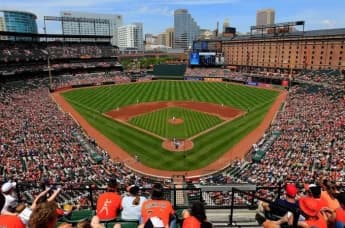From Classic Moments to Modern Marvels – The Heartbeat of Angels Baseball
Overview
Angel Stadium, nestled in Anaheim, California, stands as one of Major League Baseball’s most storied ballparks. Since its opening in 1966, it has been the home of the Los Angeles Angels, hosting countless iconic moments and legendary players. Over the decades, the stadium has evolved, blending its rich history with modern amenities to create a fan experience that is both nostalgic and cutting-edge. From its original open-air design to its transformation into a multi-purpose venue and eventual return to a baseball-first facility, Angel Stadium has remained a cornerstone of baseball in Southern California.
History and Construction
Early Plans and Development
Angel Stadium, originally known as Anaheim Stadium, was conceived in the early 1960s to provide the Los Angeles Angels with a permanent home. After sharing Dodger Stadium with the Los Angeles Dodgers, team owner Gene Autry sought a dedicated venue to establish the Angels’ identity. Anaheim, a rapidly growing city in Orange County, was chosen for its accessibility and potential to attract a large fan base. Construction began in 1964, and the stadium opened on April 19, 1966, with a capacity of over 43,000.
Expansion for Football
In the late 1970s, the stadium underwent significant changes to accommodate the NFL’s Los Angeles Rams. The outfield was enclosed, increasing capacity but altering the stadium’s original open-air design. While this made the venue suitable for football, it detracted from the intimate baseball experience that fans had come to love.
Return to Baseball
After the Rams relocated to St. Louis in 1994, Angel Stadium underwent a major renovation in the late 1990s to restore its baseball-centric design. The enclosed outfield seating was removed, and the iconic rock formation and waterfall display in center field were introduced. These changes, along with modernized seating and amenities, revitalized the stadium, making it a premier destination for baseball fans.
Architectural and Design Features
Angel Stadium’s design is a blend of classic and modern elements. Key features include:
-
The Big A: Originally a scoreboard beyond the left-field fence, the Big A was moved to the parking lot during renovations but remains a symbol of the stadium and the Angels.
-
Rock Formation and Waterfall: A visually stunning centrepiece in center field, this feature adds a unique touch to the ballpark and is activated during home runs and celebrations.
-
Open-Air Design: The stadium’s open outfield provides panoramic views and a connection to the surrounding environment, a hallmark of its original design.
-
Fan-Friendly Layout: Wide concourses, shaded seating, and family-friendly areas ensure a comfortable experience for all attendees.
Atmosphere and Fan Experience
Angel Stadium is renowned for its vibrant atmosphere and engaging fan experience. Key elements include:
-
Rally Monkey: A beloved tradition, the Rally Monkey appears on the video board to energize the crowd during crucial moments.
-
In-Game Entertainment: Between-inning activities, fan cams, and theme nights keep fans entertained throughout the game.
-
Food and Beverage: A mix of classic ballpark fare and Southern California-inspired cuisine offers something for everyone, from hot dogs to gourmet tacos.
-
Family-Friendly Amenities: Designated play areas and interactive zones make the stadium a welcoming destination for families.
Notable Events and Moments
Angel Stadium has been the stage for numerous historic events, including:
-
2002 World Series: The Angels’ first and only World Series championship, highlighted by a dramatic Game 6 comeback.
-
Nolan Ryan’s No-Hitters: The legendary pitcher recorded four of his seven no-hitters at Angel Stadium.
-
Reggie Jackson’s Three-Homer Game: A standout performance by the Hall of Famer in 1986.
-
Mike Trout’s Milestones: The superstar’s record-breaking achievements, including his 300th career home run.
-
Albert Pujols’ 600th Home Run: A grand slam that cemented his place in baseball history.
Records and Legacy
Angel Stadium has witnessed countless records and achievements, solidifying its place in baseball history. Key highlights include:
-
Nolan Ryan’s Strikeout Records: Ryan’s dominance on the mound set franchise records that still stand today.
-
Mike Trout’s Franchise Milestones: Trout’s consistent excellence has made him the face of the Angels and a frequent record-setter at the stadium.
-
Team Achievements: The 2002 World Series victory remains the pinnacle of the Angels’ success, with Angel Stadium at the heart of the celebration.
Visiting Angel Stadium
A visit to Angel Stadium is a must for any baseball fan. Key tips for visitors include:
-
Transportation: Easily accessible by car or public transit, with ample parking and nearby train services.
-
Seating Options: From luxury suites to outfield seats, the stadium offers a range of viewing experiences.
-
Food and Merchandise: Enjoy a variety of culinary options and shop for Angels gear at the team store.
-
Stadium Tours: Behind-the-scenes tours provide a deeper look at the venue’s history and operations.
Future Prospects
While Angel Stadium remains a beloved venue, discussions about its future continue. Potential renovations or a new stadium could further enhance the fan experience and ensure the venue remains competitive with modern standards. Regardless of its future, Angel Stadium’s legacy as a historic and iconic ballpark is secure.
Conclusion
Angel Stadium is more than just a ballpark; it is a symbol of baseball’s enduring appeal and a testament to the passion of Angels fans. From its storied history to its modern amenities, the stadium offers an unforgettable experience for all who visit. Whether witnessing a historic moment or simply enjoying a game with family and friends, Angel Stadium remains a cornerstone of Major League Baseball and a cherished destination for fans around the world.






